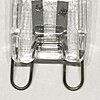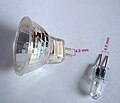
An electric light, lamp, or light bulb is an electrical component that produces light. It is the most common form of artificial lighting. Lamps usually have a base made of ceramic, metal, glass, or plastic which secures the lamp in the socket of a light fixture, which is often called a "lamp" as well. The electrical connection to the socket may be made with a screw-thread base, two metal pins, two metal caps or a bayonet mount.
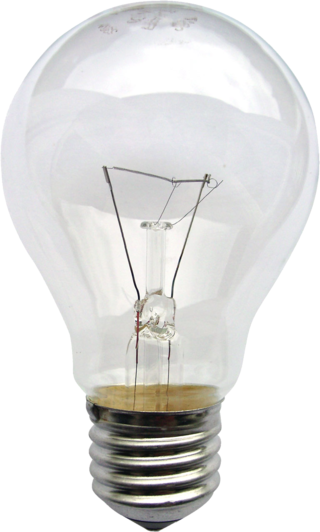
An incandescent light bulb, incandescent lamp or incandescent light globe is an electric light with a filament that is heated until it glows. The filament is enclosed in a glass bulb that is either evacuated or filled with inert gas to protect the filament from oxidation. Electric current is supplied to the filament by terminals or wires embedded in the glass. A bulb socket provides mechanical support and electrical connections.
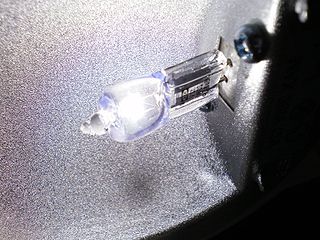
A halogen lamp is an incandescent lamp consisting of a tungsten filament sealed in a compact transparent envelope that is filled with a mixture of an inert gas and a small amount of a halogen, such as iodine or bromine. The combination of the halogen gas and the tungsten filament produces a halogen-cycle chemical reaction, which redeposits evaporated tungsten on the filament, increasing its life and maintaining the clarity of the envelope. This allows the filament to operate at a higher temperature than a standard incandescent lamp of similar power and operating life; this also produces light with higher luminous efficacy and color temperature. The small size of halogen lamps permits their use in compact optical systems for projectors and illumination. The small glass envelope may be enclosed in a much larger outer glass bulb, which has a lower temperature, protects the inner bulb from contamination, and makes the bulb mechanically more similar to a conventional lamp.

Artificial lighting technology began to be developed tens of thousands of years ago and continues to be refined in the present day.
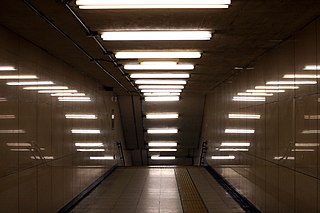
A fluorescent lamp, or fluorescent tube, is a low-pressure mercury-vapor gas-discharge lamp that uses fluorescence to produce visible light. An electric current in the gas excites mercury vapor, to produce ultraviolet and make a phosphor coating in the lamp glow. Fluorescent lamps convert electrical energy into useful light much more efficiently than incandescent lamps, but are less efficient than most LED lamps. The typical luminous efficacy of fluorescent lamps is 50–100 lumens per watt, several times the efficacy of incandescent bulbs with comparable light output.
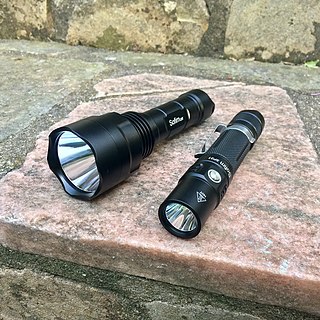
A flashlight or electric torch, usually shortened to torch, is a portable hand-held electric lamp. Formerly, the light source typically was a miniature incandescent light bulb, but these have been displaced by light-emitting diodes (LEDs) since the early 2000s. A typical flashlight consists of the light source mounted in a reflector, a transparent cover to protect the light source and reflector, a battery, and a switch, all enclosed in a case.

A compact fluorescent lamp (CFL), also called compact fluorescent light, energy-saving light and compact fluorescent tube, is a fluorescent lamp designed to replace an incandescent light bulb; some types fit into light fixtures designed for incandescent bulbs. The lamps use a tube that is curved or folded to fit into the space of an incandescent bulb, and a compact electronic ballast in the base of the lamp.

A light fixture, light fitting, or luminaire is an electrical lighting device containing one or more light sources, such as lamps, and all the accessory components required for its operation to provide illumination to the environment. All light fixtures have a fixture body and one or more lamps. The lamps may be in sockets for easy replacement—or, in the case of some LED fixtures, hard-wired in place.

Mazda was a trademarked name registered by General Electric (GE) in 1909 for incandescent light bulbs. The name was used from 1909 to 1945 in the United States by GE and Westinghouse. Mazda brand light bulbs were made for decades after 1945 outside the US. The company chose the name due to its association with Ahura Mazda, the transcendental and universal God of Zoroastrianism, whose name means light of wisdom in the Avestan language.

A parabolic aluminized reflector lamp is a type of electric lamp that is widely used in commercial, residential, and transportation illumination. It produces a highly directional beam. Usage includes theatrical lighting, locomotive headlamps, aircraft landing lights, and residential and commercial recessed lights.

A bayonet mount or bayonet connector is a fastening mechanism consisting of a cylindrical male side with one or more radial pegs, and a female receptor with matching L-shaped slot(s) and with spring(s) to keep the two parts locked together. The slots are shaped like a capital letter L with serif ; the peg slides into the vertical arm of the L, rotates across the horizontal arm, then is pushed slightly upwards into the short vertical "serif" by the spring; the connector is no longer free to rotate unless pushed down against the spring until the peg is out of the "serif".

Edison screw (ES) is a standard lightbulb socket for electric light bulbs. It was developed by Thomas Edison (1847–1931), patented in 1881, and was licensed in 1909 under General Electric's Mazda trademark. The bulbs have right-hand threaded metal bases (caps) which screw into matching threaded sockets. For bulbs powered by AC current, the thread is generally connected to neutral and the contact on the bottom tip of the base is connected to the "live" phase.

A multifaceted reflector light bulb is a reflector housing format for halogen as well as some LED and fluorescent lamps. MR lamps were originally designed for use in slide projectors, but see use in residential lighting and retail lighting as well. They are suited to applications that require directional lighting such as track lighting, recessed ceiling lights, desk lamps, pendant fixtures, landscape lighting, retail display lighting, and bicycle headlights. MR lamps are designated by symbols such as MR16 where the diameter is represented by numerals indicating units of eighths of an inch. Common sizes for general lighting are MR11 and MR16, with MR8 and MR20 used in specialty applications. Many run on low voltage rather than mains voltage alternating current so require a power supply.

An LED lamp or LED light is an electric light that produces light using light-emitting diodes (LEDs). LED lamps are significantly more energy-efficient than equivalent incandescent lamps and fluorescent lamps. The most efficient commercially available LED lamps have efficiencies exceeding 200 lumens per watt (lm/W) and convert more than half the input power into light. Commercial LED lamps have a lifespan several times longer than both incandescent and fluorescent lamps.

Philip H. Diehl was a German-American mechanical engineer and inventor who held several U.S. patents, including electric incandescent lamps, electric motors for sewing machines and other uses, and ceiling fans. Diehl was a contemporary of Thomas Edison and his inventions caused Edison to reduce the price of his incandescent bulb.

Holiday lighting technology has been subject to considerable development and variation since the replacement of candles by electric lights. While originally used during the Christmas holidays as Christmas lights, modern electric light arrays have become popular around the world in many cultures and are used both during religious festivals and for other purposes unconnected to any festivities.

A wedge base is a type of electrical connector used as a fitting for small light bulbs. It is similar to the bi-pin connector, except that the two "pins" are the same wires that extend into the bulb, and the wires are bent up onto the sides of the base, where they make contact with the socket. The wires are usually inserted into a plastic base that the bulb is mounted in, and which is often narrower at the tip than at the bulb, giving it a wedge shape and usually ensuring a tight connection, depending on manufacturing tolerances. Some bulbs have no plastic base, and the wires are simply bent up to the sides of the bulb's glass base.
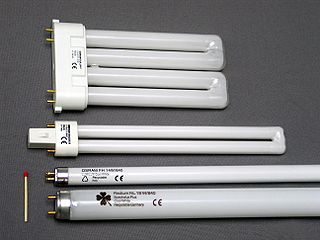
Since their introduction as a commercial product in 1939, many different types of fluorescent lamp have been introduced. Systematic nomenclature identifies mass-market lamps as to overall shape, power rating, length, color, and other electrical and illuminating characteristics.
A lightbulb socket, lightbulb holder,light socket, lamp socket or lamp holder is a device which mechanically supports and provides electrical connections for a compatible electric lamp base. Sockets allow lamps to be safely and conveniently replaced (re-lamping). There are many different standards for lampholders, including early de facto standards and later standards created by various standards bodies. Many of the later standards conform to a general coding system in which a socket type is designated by a letter or abbreviation followed by a number.
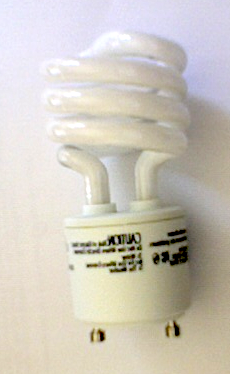
A GU24 lamp fitting is a bi-pin connector for compact fluorescent lamps (CFL) or LED lamps that uses a bayonet mount–like twist-lock bi-pin connector instead of the Edison screw fitting used on many CFLs, LED lamps and incandescent light bulbs. The design was initiated by the U.S. EPA and the Lighting Research Center in 2004, in order to facilitate the deployment of compact fluorescent light bulbs with replaceable ballasts.






